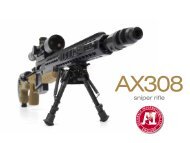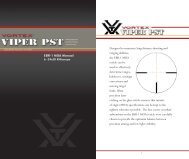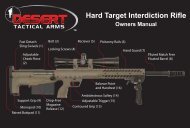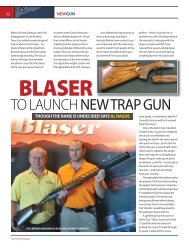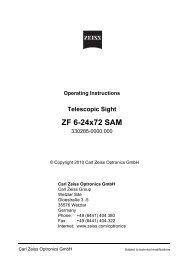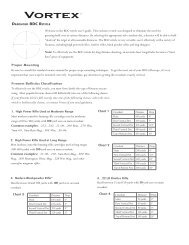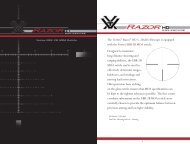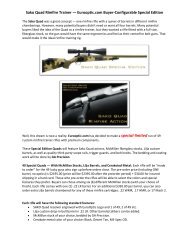Vortex 6-24x50 EBR-1 MRAD reticle manual - Euro Optics Ltd.
Vortex 6-24x50 EBR-1 MRAD reticle manual - Euro Optics Ltd.
Vortex 6-24x50 EBR-1 MRAD reticle manual - Euro Optics Ltd.
Create successful ePaper yourself
Turn your PDF publications into a flip-book with our unique Google optimized e-Paper software.
PRECISION<br />
SHOOTING<br />
TACTICAL<br />
SECOND FOCAL PLANE<br />
<strong>Vortex</strong> <strong>EBR</strong>-1 MOA Reticle<br />
<strong>EBR</strong>-1 <strong>MRAD</strong> Manual<br />
6–<strong>24x50</strong> Riflescope<br />
Designed to maximize long distance shooting and<br />
ranging abilities,<br />
the <strong>EBR</strong>-1 <strong>MRAD</strong><br />
<strong>reticle</strong> can be<br />
used to effectively<br />
determine ranges,<br />
holdovers, windage<br />
corrections<br />
and moving<br />
target leads.<br />
Ultra precision<br />
laser etching on the glass <strong>reticle</strong> ensures that mrad<br />
specifications can be kept to the tightest tolerances<br />
possible. The fine center crosshair subtensions on the<br />
<strong>EBR</strong>-1 <strong>MRAD</strong> <strong>reticle</strong> were carefully chosen to provide<br />
the optimum balance between precision aiming and low<br />
light visibility.<br />
1
<strong>MRAD</strong> Subtensions<br />
The <strong>EBR</strong>-1 <strong>MRAD</strong> <strong>reticle</strong> is based on the milliradian, or mrad<br />
for short. Mrad unit of arc measurements are based on the<br />
radian. A radian is the angle subtended at the center of a circle<br />
by an arc that is equal in length to the radius of the circle.<br />
There are 6.283 radians in a circle and 1000 milliradians in a<br />
radian for a total of 6283 milliradians (mrads) in a circle. An<br />
mrad will subtend 3.6 inches at a distance of 100 yards. Most<br />
riflescopes using mrad adjustments will use .1 mrad clicks<br />
which subtend .36 inches at 100 yards.<br />
listed spec. If magnification is set at 1/4 of full magnification,<br />
subtension values will be four times the <strong>manual</strong> listed spec.<br />
To help calculate range, holdover, wind drift at magnifications<br />
other than full power, the Viper PST 6–<strong>24x50</strong> riflescope uses a<br />
dual number marking system on the magnification dial. The 1x,<br />
2x, 3x, 4x subtension multiplier markings on the back side of the<br />
magnification numbers can be used in conjunction with the <strong>reticle</strong><br />
to help calculate distances and holdovers at varying magnifications.<br />
Both mrad and MOA measurements are effective for ranging<br />
and bullet trajectory drop compensation in <strong>reticle</strong> designs.<br />
However, the mrad method used in the <strong>EBR</strong>-1 <strong>MRAD</strong> <strong>reticle</strong><br />
has some important advantages over an MOA method. The<br />
primary benefit is that once learned, it is much simpler and<br />
faster to use. The mrad system will also be very easy for<br />
shooters familiar with the metric system and for those shooters<br />
with previous training in using mil dot <strong>reticle</strong>s.<br />
<strong>EBR</strong>-1 Reticle Subtensions<br />
Heavy crosshair<br />
subtends .3 mrads<br />
.5 mrads .2 mrads<br />
Fine crosshair<br />
subtends .02 mrads<br />
Gap subtends<br />
.3 mrads<br />
In this second focal plane riflescope, the listed mrad subtensions<br />
are only valid at the highest magnification of the scope.<br />
However, by understanding the relationship of magnification<br />
and subtensions, ranging, holdovers and wind drift can still<br />
be calculated at partial magnifications. If magnification is set<br />
at 1/2 of full magnification, subtension values will be two<br />
times the <strong>manual</strong> listed spec. If magnification is set at 1/3 full<br />
magnification, subtension values will be three times the <strong>manual</strong><br />
Model<br />
6–<strong>24x50</strong><br />
Reticle<br />
subtensions<br />
valid at 24x<br />
Subtension Changes with Magnification<br />
Riflescope<br />
Magnification<br />
24x<br />
12x<br />
8x<br />
6x<br />
Reticle<br />
Multiplier<br />
1x<br />
2x<br />
3x<br />
4x<br />
Actual Subtension<br />
of 1 mrad Reticle Space<br />
1 mrad<br />
2 mrads<br />
3 mrads<br />
4 mrads<br />
2 3
Ranging<br />
Mrad <strong>reticle</strong>s such as the <strong>EBR</strong>-1 are very effective for<br />
ranging using simple formulas.<br />
Mrad Ranging Formulas<br />
Example<br />
Target Size (Yards) x 1000<br />
mrads Read<br />
=<br />
Range (Yards)<br />
Target Size (Meters) x 1000<br />
mrads Read<br />
=<br />
Range (Meters)<br />
Target Size (Inches) x 27.8<br />
mrads Read<br />
=<br />
Range (Yards)<br />
To use these formulas, you will need to know the<br />
measured size of the target or a nearby object. Using<br />
either the vertical or horizontal mrad scale, place the<br />
<strong>reticle</strong> on the target of known measurement and read the<br />
number of mrads spanned.<br />
Accurate measuring will depend on a very steady hold—<br />
the rifle should be solidly braced using a rest, bipod or<br />
sling. Once you have an accurate mrad reading, use any of<br />
the listed ranging formulas to calculate distance.<br />
Ranging a man (1 meter from groin to top of head) at<br />
2 mrads yields 500 meters.<br />
1 x 1000<br />
=500 Meters<br />
2 mrads<br />
Maximum accuracy in ranging will be obtained by<br />
calculating exact mrad measurements—mrads should be<br />
estimated in tenths if possible.<br />
4 5
Elevation Holdovers<br />
Once the distance has been calculated using the<br />
<strong>EBR</strong>-1 <strong>MRAD</strong> <strong>reticle</strong> or a laser rangefinder, the<br />
<strong>EBR</strong>-1 can be used for rapid holdover correction for<br />
bullet drop of the cartridge being used. To get the<br />
most benefit out of the <strong>EBR</strong>-1 equipped riflescope,<br />
<strong>Vortex</strong> <strong>Optics</strong> highly recommends shooters learn<br />
their bullet drop numbers in mrads rather than<br />
inches or MOAs. (Remember that 1 mrad equals<br />
3.44 MOA or 3.6 inches per 100 yards).<br />
Example<br />
Since the <strong>EBR</strong>-1 <strong>reticle</strong> is scaled in mrads, it is an<br />
easy job to quickly select the correct drop reference<br />
line once the shooter knows knows their bullet<br />
drops and windage/lead corrections in mrads. If<br />
the shooter prefers to dial come ups for bullet drop<br />
using the elevation knob, knowing bullet drops in<br />
mrads will allow for much faster adjustments as the<br />
mrads can be quickly read on the elevation knob.<br />
3 mrad correction for 500-yard shot. No wind.<br />
6 7
Windage and Moving Targets<br />
The <strong>EBR</strong>-1 <strong>reticle</strong> is highly effective when used<br />
for wind and moving target leads.<br />
Using the <strong>reticle</strong> for effective windage and<br />
moving leads will require thorough knowledge<br />
of your weapon system’s ballistic performance<br />
under varying conditions and experience in<br />
reading wind strengths and target speeds. As in<br />
bullet drops, it is imperative the shooter learn<br />
the particular weapon’s windage/moving target<br />
corrections in mrads rather than inches or MOAs.<br />
Example<br />
15 mph wind<br />
Full value wind at 90 degrees<br />
Basic windage correction on center crosshair<br />
When dialing elevation come ups, the center<br />
horizontal crosshair will be used for windage or<br />
moving lead corrections.<br />
2.6 mrad correction for 15 mph wind at 700 yards.<br />
Elevation already dialed into turret.<br />
8 9
Basic windage correction using drop line on <strong>reticle</strong><br />
When using the <strong>reticle</strong> for elevation correction rather than<br />
dialing, the mrad marks on the center horizontal crosshair<br />
can still be used to help visually reference windage<br />
corrections. Remember to hold the <strong>reticle</strong> into the wind.<br />
Example<br />
Basic moving lead correction<br />
When estimating moving target leads, the mrad marks on<br />
the center horizontal crosshair and can be used. Estimating<br />
moving leads will require knowing yardage distance, wind<br />
speed, moving target speed and total bullet flight times inc.<br />
rifle lock time. Bullet flight times can be roughly calculated<br />
based on fps velocities or a ballistic calculator.<br />
Note: Correctly estimating moving leads is very diffi cult and requires<br />
considerable practice and knowledge beyond the scope of this <strong>manual</strong>.<br />
Example<br />
10 mph wind<br />
Full value wind at 90 degrees<br />
Walking Direction<br />
Using 3 mrad drop line at 500 yards, 2 mrad correction for 10 mph wind.<br />
2.74 mrad correction for a man walking at 3 mph at 800 yards. No wind.<br />
Total bullet time of fl ight from trigger pull 1.5 seconds during which man<br />
travels 6.6 feet. Elevation already dialed into turret.<br />
10 11
<strong>Vortex</strong> Service and Repair Policy<br />
vortexoptics.com<br />
Unconditional Lifetime Warranty<br />
<strong>Vortex</strong> <strong>Optics</strong> wants you to shoot<br />
and use your Viper PST riflescope<br />
under any conditions with<br />
complete confidence—that’s why<br />
our warranty is straightforward<br />
and simple:<br />
• Fully transferable<br />
Unconditional Lifetime<br />
Warranty<br />
• No warranty card needed<br />
• No receipt needed<br />
Rest assured, if this riflescope should ever require repair, all<br />
you need to do is contact <strong>Vortex</strong> for absolutely free service.<br />
Call 800-426-0048 or e-mail service@vortexoptics.com.<br />
<strong>Vortex</strong> <strong>Optics</strong><br />
2120 West Greenview Drive<br />
Middleton, Wisconsin 53562<br />
USA<br />
Patent Pending<br />
Dual Use: Shooting Tactical / Hunting<br />
Manual #R-624S1-M<br />
12



